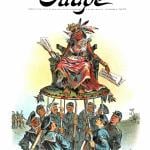“The pastor closes his sermon: “The Holy Spirit bids you come. The congregation, praying, hoping, expectant, bids you come. On the first note of the first stanza, come down one of these stairways, down one of these aisles. May angels attend you. May the Holy Spirit of God encourage you. May the presence of Jesus walk by your side as you come, while we stand and while we sing.” And come they do. Week after week, in churches all across the America—and other parts of the world—scenes like this play out at the end of thousands of sermons. The congregation stands and sings “Just As I Am” or “Come Just as You Are.” Sinners walk the aisle and pray for salvation.”
So begins a recent article on the excellent Church History website by TEDS historian Douglas A. Sweeney and TEDS PhD student Mark C. Rogers entitled “Walk the Aisle.” I would encourage you to read the very nicely written and researched study and to reflect on it (and while you’re at it, check out and support Church History).
Here’s a nice section on the 19th-century development of the practice:
“Many people consider Charles Grandison Finney (1792-1875) to be the “father” of the altar call. Ordained as a Presbyterian minister in 1823, Finney did not begin giving public invitations until long after Methodists had made the altar call a regular part of their camp meetings. Finney, however, did more than anyone to establish altar calls as an accepted and popular practice in American evangelicalism. Finney regularly called anxious sinners to the front of the congregation to sit on an “anxious bench.” There, they would receive prayer and often be preached to directly. The altar call was also one of Finney’s famous “new measures.” He was convinced that ministers could produce revival by using the right methods, and that the altar call “was necessary to bring [sinners] out from among the mass of the ungodly to a public renunciation of their sinful ways.”
The even-handed conclusion of the article:
“Despite criticism, the altar call continues. It has become a permanent fixture in American evangelicalism. One need only watch a few minutes of a Billy Graham crusade on TV to recognize that what was once a “new measure” has become mainstream. Graham’s distinctive voice calls out, “Up there—down there—I want you to come. If you are with friends and relatives, they will wait for you. The buses will wait for you. Christ went all the way to the Cross because He loved you. Certainly you can come these few steps and give your life to Him.” While the venue has changed from the backwoods of Kentucky to modern football stadiums, and the mode of transportation has evolved from covered wagons to charter buses, the altar call has endured. It is featured even today in the stories of countless Christians who met Christ when they stood up, stepped out, and walked the aisle.”
I used to get very exercised about things like the altar-call. I’ve toned down a bit, which tends to happen with a bit of seasoning. This is not to say that I would personally use an altar call (I don’t when I preach) or that I would encourage others to do so (I would not for theological reasons). With that said, though, I am aware that many people who are far more evangelistically faithful and fruitful do use the altar call and see many more people truly come to Christ than I ever will.
If one would still seek to think carefully through the practice–we must do so, after all, and should never blindly accept tradition–one can also give thanks for the many souls who past and present evangelists have led to the mercy seat of God. Whether we find Christ while walking a church aisle or sitting in a bar, desolate and lonely, we know that we Christians will all walk down a very different path in a day that is soon to come. Here, we tread on sawdust or hardwood; there, we will walk on gold, and worship the King who staggered up a hard and bitter road to bring us to our rest.











